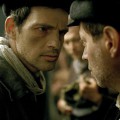Edited by Ágnes Matuska – Ervin Török
Anikó Oroszlán: Moll Cutpurse/Mary Frith – Variations on Early Modern Female Identity
It is a well-known fact that in early modern English theatre, there were no actresses, and female roles were played by boy actors. At the same time, both public and private stages provided occasions for women to appear in front of others not only as spectators, but also as performers. In this essay, I intend to analyse the figure of Mary Frith, the notorious pickpocket and highwaywoman of 17th-century London, who was an emblematic figure of female entertainment, moreover, due to her male attire, was described as a “hermaphrodite”. I will argue that her – and other women’s similar – performances can be considered as a crucial part of early modern theatre history, since viewers reflected to them similarly to those of professional actors. Also, although they could not play in front of an audience, their public appearance was condemned by the society to a great extent.
Jennifer A. Low: Bodied Forth: Spectator, Stage and Actor in the Early Modern Theater
Relying on the interpretation of early modern theatrical metaphors of the body, the paper looks into the ways in which proprioception can shape the understanding of the self through the interaction of the drama text, scenic elements, and the experience of the audience watching the play. In an analysis of the way spatial elements construct the subject, the question of penetration is given a particular emphasis as a way of entering a character’s private, inner self. Works dealing with the social experience of space (Hall, Lefebvre) are used to create a theoretical framework for the proprioceptive analysis of staging. Among the plays analyzed are Bussy D’Amboise, ’Tis Pity She’s a Whore, The Duchess of Malfi, Romeo and Juliet, and Coriolanus.
Kocic Larisa Zámbóné: Iago, the Proponent and Scapegoat of Antitheatricality
In this paper, I am examining the character of Iago, as an actor, and the effect he is having on the rest of the characters, his primary audience, within the framework of antitheatrical attacks against stage-players. That Othello might be the only Shakespearean play lacking explicit references to theatre and yet embodying the major fear of the antitheatrical writers only enhances the interest of the topic.
Csaba Maczelka: Cabbala, science and utopia: Margaret Cavendish and The Blazing World (1666)
This paper offers an interpretation of Margaret Cavendish’s The Blazing World (1666/1668) in the context of mid-17th century utopian literature and cabbalistic tradition, while at the same time touching upon certain questions related to the relationship between science and literature in the period. In both traditions, so in Cavendish’s text, too, „creation” is a central concept, whose background is the rhetorical term ‘inventio’, significantly altered already by Bacon, then even more radically, by Cavendish. Yet, despite the emphatic and celebrated ‘creative’ function attributed to literature in The Blazing World, there are signs of a growing scepticism toward the agency and scope of such a creative act, particularly in the climatic moment of self-reflection within the work. This turns Cavendish’s utopia into an exciting and remarkably early example of critical utopia.
Ágnes Matuska: Locus, platea, mundus: variations on the social play
The paper analyzes the example of an American performance artist and political activist, Reverend Billy, as an instance of a performative logic that combines ritual, theatrical and political elements. The study uses two parallel examples to interpret Reverend Billy’s unique acts: one is the ritual theatricality of the Corpus Christi plays, the other is the performative labour through which consumers maintain a brand, by identifying with roles offered by it. Weimann’s definitions of locus and platea are reinterpreted with the help of Victor Turner, and a third term, mundus is introduced, that designates a special type of theatricality, which is created by the choice or belief of the audience, and thus shapes their social reality.
Sándor Fazekas: The battle of worlds in the early modern period: political-theoretical facets of the play metaphor in ’Late helmet for a wounded brain’ a Hungarian poem cycle
The poem cycle Sebes agynak késő sisak (Late helmet for a wounded brain) was written in Hungarian, approximately in 1631. These poems present us the personages of the Thirty Year’s War, and allegorical characters who represent the states involved the most into this conflict. The first version of the original written in Latin, the Scena Europaea and a contemporary manuscript catalogue about the Sisak connects the work to the theatrical traditions. This paper tries to map up the relevance of contemporary theatrical traditions (although not connected to actual buildings of theatres) in the poems. In addition, we can find arguments against theatre in these texts. The relationship between theatrical techniques and politics was held contradictionary in that era: the Catholics, as opposed to the protestants, were convinced of the usefulness of theatrical skills on the political stage. This quarrel is personified in the figure of Gondomare in the poems.
The theatrical traditions mentioned are bound to the representative events of the era, for example the marriage of Princess Elisabeth of England and Frederick Count Palatine, in 1613. In this paper I hope to present new contexts and backgrounds to interpret both the Latin and Hungarian poems, and it is also possible that other texts of the ancient Hungarian literature can be read from the perspective of these alternative contexts.


